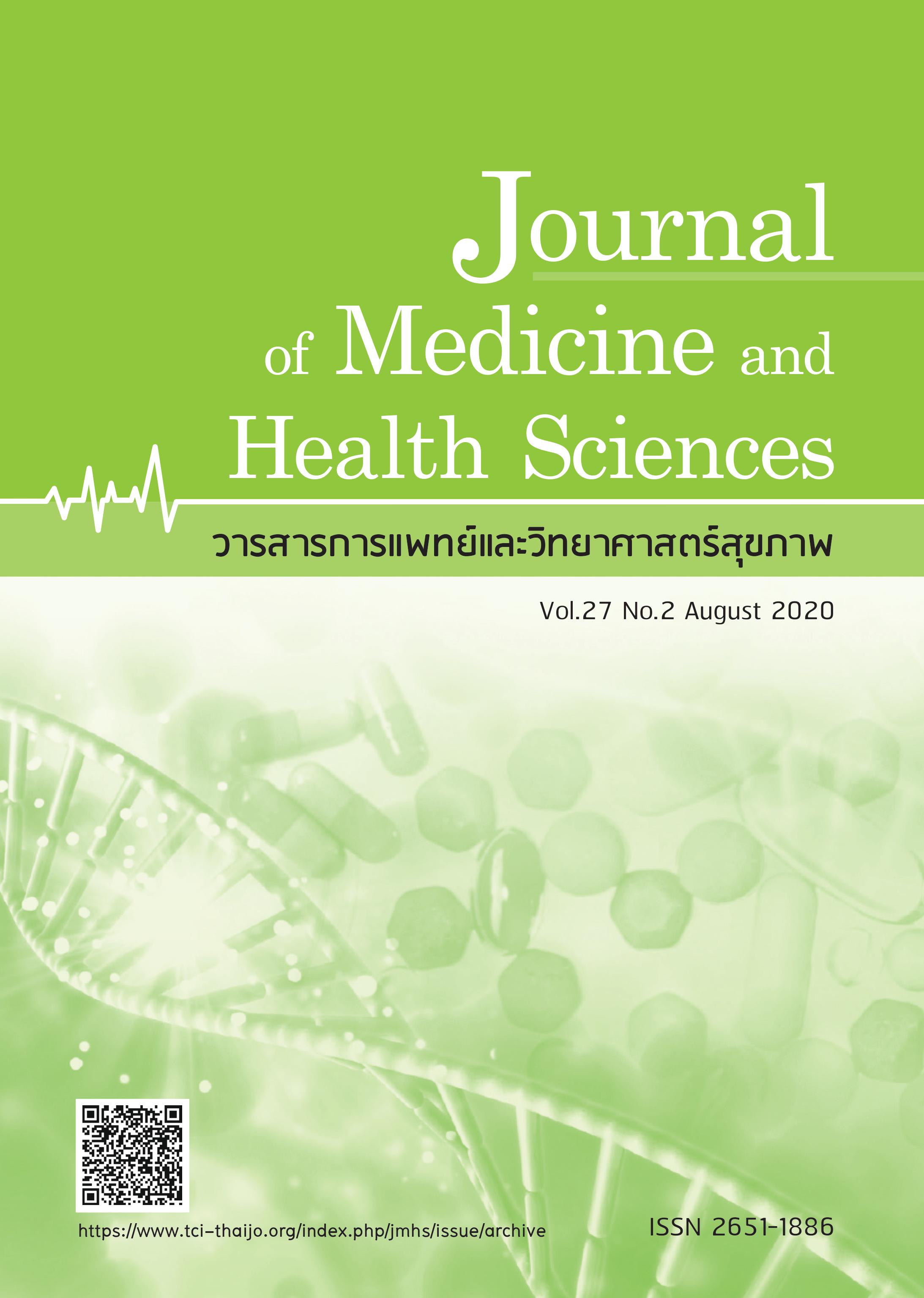Efficacy of topical capsaicin for treatment of chemotherapy-induced peripheral neuropathy
Keywords:
capsaicin, neuropathy, CIPN, chemotherapy, topicalAbstract
Chemotherapy-induced peripheral neuropathy (CIPN) is a commonly problem entity following many chemotherapies for cancer therapy, among which sensory abnormalities and pain are common and the most suffering issues. Current treatments for CIPN are largely ineffective. Topical capsaicin is produced from chili pepper extraction and effective for treatment of neuropathic pain in diabetic neuropathy, postherpetic neuropathy and HIV-associated neuropathy. Topical capsaicin was approved in Thai FDA for these indications. There are no studies of capsaicin cream in CIPN. This study assessed the efficacy of topical capsaicin in CIPN patients. This study is prospective study. Our study consisted of 50 patients with clinically confirm chemotherapy-induced peripheral neuropathy from various antineoplastic agents. They were treated with topical capsaicin at area of neuropathy and neuropathic pain. Baseline characteristics including primary cancer site, neurotoxic agent and cumulative dose, prior treatments were recorded. Symptoms were monitored and followed using the numerical rating scale (NRS), Grading of neurotoxicity by NCI-CTCAE version 4.0 and questionnaires of neurotoxicity and quality of life in these toxicities (FACT/GOG-NTX and EORTC-QLQ CIPN 20). These documents were collected at baseline, 1 week and 4 weeks after topical capsaicin application, including toxicities of this agent. A mixed effects linear regression model was applied to identify efficacy of topical capsaicin. These 50 patients with CIPN reported significant reduction all of scoring at 4 weeks after application. NRS = -0.35 (95%CI: -0.50, -0.20), Neurotoxicity by NCI-CTCAE = -0.09 (95%CI: -0.15, -0.02), FACT/GOG-NTX = -2.80 (95%CI: -3.50, -2.10) and EORTCQLQ CIPN score = -5.13 (95%CI: -6.17, -4.08). Global assessment of quality of life was improve by overall score. The efficacy and quality of life were constant after 1 week to 4 weeks after application. 21 (42%) patients has reported toxicities with burning but those are mild symptoms without quality of life effects. Topical capsaicin
has efficacy in significant reduction CIPN symptoms and improves quality of life of these patients.
References
2. Mols F, Beijers T, Vreugdenhil G, et al. Chemotherapy-induced peripheral neuropathy and its association with quality of life: a systematic review. Support Care Cancer 2014;22(8):2261-9.
3. Chaudhry V, Rowinsky EK, Sartorius SE, et al. Peripheral neuropathy from taxol and cisplatin combination chemotherapy: clinical and electrophysiological studies.Ann Neurol 1994;35(3):304-11.
4. Kautio AL, Haanpaa M, Kautiainen H, et al. Burden of chemotherapy-induced neuropathy-a cross-sectional study.Support Care Cancer 2011;19(12):1991-6.
5. Padman S, Lee J, Kumar R, et al. Late effects of oxaliplatin-induced peripheral neuropathy (LEON)--cross-sectional cohort study of patients with colorectal cancer surviving at least 2 years. Support Care Cancer 2015;23(3):861-9.
6. Park HJ. Chemotherapy induced peripheral neuropathic pain. Korean J Anesthesiol 2014;67(1):4-7.
7. Nutsara P, Chanukorn K, Panatchaya K, et al. Chemotherapy-Induced Peripheral Neuropathy (CIPN): A Cross-Sectional Study in Cancer Patients. J Nursing 2017;52-62.
8. Seretny M, Currie GL, Sena ES, et al. Incidence, prevalence, and predictors of chemotherapy-induced peripheral neuropathy: A systematic review and meta-analysis. Pain 2014;155(12):2461-70.
9. Park SB, Goldstein D, Krishnan AV, et al. Chemotherapy-induced peripheral neurotoxicity: a critical analysis. CA Cancer J Clin 2013;63(6):419-37.
10. Wampler M. Chemotherapy-induced peripheral neuropathy fact sheet for health professionals. Proceedings of APTA; 2016: May 4.
11. Cavaletti G, Cornblath DR, Merkies IS, et al. The chemotherapy-induced peripheral neuropathy outcome measures standardization study: from consensus to the first validity and reliability findings. Ann Oncol 2013;24(2):454-62.
12. Yang YH, Lin JK, Chen WS, et al. Duloxetine improves oxaliplatin-induced neuropathy in patients with colorectal cancer: an open-label pilot study. Support Care Cancer 2012;20(7):1491-7.
13. Durand JP, Brezault C, Goldwasser F. Protection against oxaliplatin acute neurosensory toxicity by venlafaxine. Anticancer Drugs 2003;14(6):423-5.
14. Rao RD, Michalak JC, Sloan JA, et al. Efficacy of gabapentin in the management of chemotherapy-induced peripheral neuropathy: a phase 3 randomized, doubleblind, placebo-controlled, crossover trial (N00C3). Cancer 2007;110(9):2110-8.
15. Cartoni C, Brunetti GA, Federico V, et al. Controlled-release oxycodone for the treatment of bortezomib-induced neuropathic pain in patients with multiple myeloma. Support Care Cancer 2012;20(10):2621-6.
16. Fallon MT, Storey DJ, Krishan A, et al. Cancer treatment-related neuropathic pain: proof of concept study with menthol-a TRPM8 agonist. Support Care Cancer 2015;23:2769-77.
17. Gewandter JS, Mohile SG, Heckler CE, et al. A phase III randomized, placebocontrolled study of topical amitriptyline and ketamine for chemotherapyinduced peripheral neuropathy (CIPN): A University of Rochester CCOP study of 462 cancer survivors. Support Care Cancer 2014;22:1807-14.
18. Spicarova D. and Palecek J. The role of spinal cord vanilloid (TRPV1) receptors in pain modulation. Physiol Res 57 (Suppl.3);S69-77.
19. Filipczak BI, Krzyzewski RM, Kucharz J. et al. High-dose 8% capsaicin patch in treatment of chemotherapy-induced peripheral neuropathy: single-center experience. Med Oncol 2017;34:162.
20. Wagner T, Poole C, Roth-Daniek A. The capsaicin 8% patch for neuropathic pain in clinical practice: a retrospective analysis. Pain Med 2013;14:1202-11.
21. Backonja M, Wallace MS, Blonsky ER, et al. NGX-4010, a highconcentration capsaicin patch, for the treatment of postherpetic neuralgia: a randomised, double-blind study. Lancet Neurol 2008;7:1106-12.
22. Simpson DM, Brown S, Tobias J, et al. Controlled trial of high-concentration capsaicin patch for treatment of painful HIV neuropathy. Neurology 2008;70(24):2305-13.
23. Derry S, Sven-Rice A, Cole P, et al. Topical capsaicin (high concentration) for chronic neuropathic pain in adults. Cochrane Database Syst Rev 2013(2):CD007393.
24. Mou J, Paillard F, Turnbull B, et al. Efficacy of Qutenza(R) (capsaicin) 8% patch for neuropathic pain: a meta-analysis of the Qutenza Clinical Trials Database. Pain 2013;154(9):1632-9



